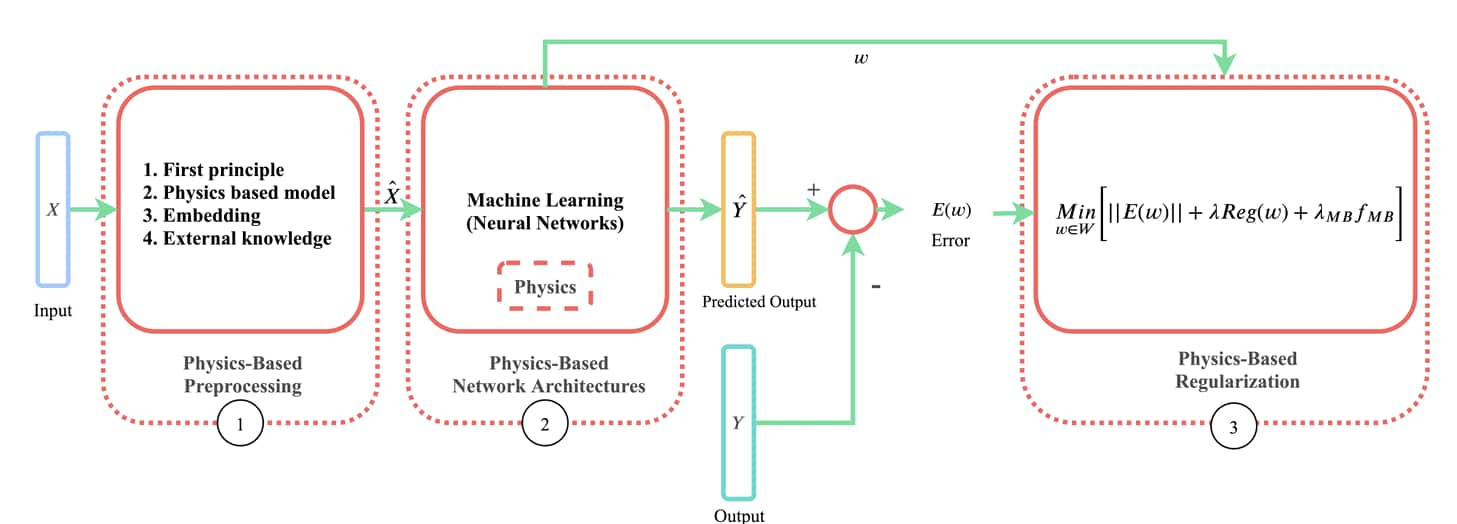1. Enhanced Accuracy and Reliability:
By grounding ML models in known physics, HB methods reduce the prediction error that purely data-driven models might suffer from, especially in scenarios where data is scarce or noisy.
2. Improved Interpretability:
Unlike black-box models of pure ML, hybrid models incorporate understandable physical laws, which help trace the logic behind predictions, making the models more transparent and trustworthy.
3. Efficient Use of Data:
Physics-based constraints require less empirical data to train effectively. This is particularly beneficial in fields where data collection is expensive or impractical, allowing for continued research and application development without extensive datasets.
4. Domain Adaptability:
Hybrid models can be quickly adapted to new domains that share underlying physical laws, unlike traditional ML models that often need to be rebuilt from scratch when applied to different scenarios.
5. Reduced Computational Costs:
By integrating known equations, the computational burden typically associated with training purely data-driven models is significantly lowered, enabling faster and more efficient computations.
PHysIcS Classification System for Various HB Techniques
The PHySIcs-ML classification system provides a structured way to navigate the burgeoning field of hybrid physics-guided machine learning techniques. "PHySIcS" stands for Physics, Hybrid, Systems, and Scientific in Machine Learning. Each category highlights different integration methods and their suitable applications, ranging from real-time adaptive updates to discovery-driven data analysis. This classification system will focus on differentiating these approaches based on their integration type, application focus, and inherent techniques.
P: Physics-Integrated Learning (PIL)
These models start with physics-based or theoretical models to ensure the foundational structure of the machine learning algorithms adheres to physical laws. This category ensures models are not only data-driven but also constrained and guided by well-established scientific principles.
Techniques in PIL:
- Constraint-Based Learning: Integrating physical constraints into learning algorithms to guide the solution space (e.g., conservation laws in energy models).
- Theory-Driven Feature Engineering: Using physics-based theories to craft features that machine learning models use, improving model interpretability and stability.
H: Hybrid Adaptive Models (HAM)
HAMs utilize adaptive techniques that allow machine learning models to update and recalibrate based on new data while still adhering to physics-based models. These are particularly useful in dynamic systems where conditions change over time.
Techniques in HAM:
- Online Learning Algorithms: Updating models in real-time using streaming data.
- Reinforcement Learning: Integrating physics-guided simulations as environments for training agents to perform specific tasks, ensuring actions adhere to physical laws.
S: Systems Integration Models (SIM)
SIM involves developing comprehensive models that incorporate multiple types of data and physical equations to provide a holistic view of the system being studied. These complex models are often used in multidisciplinary areas.
Techniques in SIM:
- Coupled Models: Integrating different physical models (e.g., fluid dynamics and chemical kinetics) to study interactions under various conditions.
- Ensemble Techniques: Using a combination of multiple models to improve predictions, where each model brings a unique perspective or data interpretation.
S: Scientific Machine Learning (SciML)
SciML is at the frontier of integrating scientific theories (physical laws, biological theories) directly into machine learning frameworks, enhancing both the interpretability and applicability of predictive models.
Techniques in SciML:
- Physics-Informed Neural Networks (PINNs): Neural networks that are trained to solve supervised learning tasks while respecting any given laws of physics expressed by general differential equations.
- Symbolic Regression: Discovering the underlying equations of complex systems directly from data, guided by physical laws.
Top Three Key Applications of Hybrid Physics Guided Machine Learning
1. Predictive Maintenance:
Predictive maintenance in industrial settings is a prime example of HB methods at work. By combining physics-based models that predict equipment failure under standard operating conditions with ML algorithms that adapt to unique or changing conditions, companies can preemptively address failures, thereby minimizing downtime and maintenance costs.
2. Intelligent Control Systems:
In robotics and automated systems, integrating MB and ML allows for more robust control strategies that enhance the precision and efficiency of movements and operations by predicting and adapting to real-time environmental changes.
3. Energy Systems:
For energy management, especially in renewable resources, hybrid models help in forecasting power output by considering both historical data patterns and physics-based phenomena (like solar irradiance and wind speed profiles), leading to more reliable energy supply predictions.
Future of Hybrid Modeling
The field of Hybrid Physics Guided Machine Learning is rapidly advancing, with researchers continually exploring new ways to integrate data-driven and physics-based techniques. As computational power increases and more sophisticated algorithms are developed, the potential applications of HB methods will expand dramatically. This not only promises to enhance the capabilities of cyber-physical systems but also opens up new possibilities in fields as diverse as environmental science, aerospace, and even finance.
Hybrid Physics Guided Machine Learning represents a significant step forward in the modeling of complex systems. By harnessing both the predictive power of machine learning and the explanatory power of physical models, HB techniques offer a powerful toolkit for scientists and engineers looking to solve tomorrow's problems today. As this field grows, it will undoubtedly catalyze further innovations that bridge the gap between theoretical physics and practical machine learning applications.
You might also want to explore these related blogs.
Unlocking the Power of AI Easy Steps to Learn and Know Where to Implement Artificial Intelligence
What is Artificial General Intelligence (AGI)? Implications for Industry and Learners
Machine Learning in Manufacturing: An Overview of Industry 4.0 Applications




